Stone walled-ruin settlement from Longshan Period found in Zhaimaoliang Site, Shaan’xi Province
From:Chinese Archaeology NetWriter:Date:2015-12-28
Zhaimaoliang Site is located in Yulin City, Shaan’xi Province, covering about 30,000 square meters. From 2014 to 2015, salvage excavation has been carried out by Shaan’xi Provincial Institute of Archaeology and Yulin Exploration Team of Cultural Relics and Archaeology in order to cooperate with infrastructure. A well-preserved and small sized stone walled-ruin settlement from Longshan Period with rich remains was uncovered.
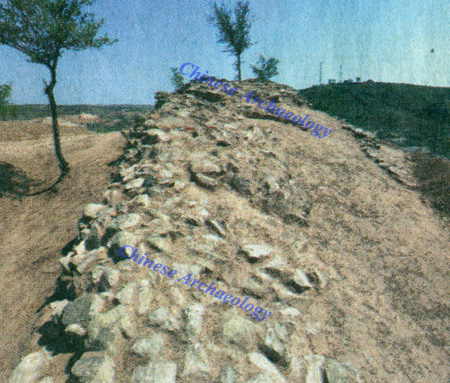
South wall of Zhaimaoliang Site
Main archaeological features excavated in Zhaimaoliang Site conclude the south part of the wall, 109 (groups of) house foundation and 14 ash pits. The wall was constructed with sandy-rock stones which were mainly discovered in the southern side of the site. It’s about 200m long and in a “L” shaped plane. In 2014, about 40m long wall from the east to the west was cleared, which had an obviously defensive function. The height is 0.8m residue and the width is roughly 1m. Besides, it was built by stones paved flatly. There were no distinctly processing traces found in stones. It’s worth mentioning that there was a revetment being built by blocks of stones outside this section wall, roughly paralleling with it.
The main achievement of the excavation of Zhaimaoliang Site is the numerous and well-preserved house foundations. There are 109 (groups of) house foundations being cleared and distributed along contour lines high and low scattered in an arc-shape. They can be roughly divided into 4 or 5 rows from the lower part to the higher part. It’s easy to see that these houses are distributed in groups. What’s more, all the gateways face lower part of the slope.

House foundation excavated in 2014
The house foundations in Zhaimaoliang site are all set structures containing two connected parts, the front room and the back room which are arranged on a straight line. The front room is usually subterranean with a rectangular plane. There are post holes on the floor which indicates that there was roof on the top of the front room. Besides, ovens on the walls are discovered, too. All back rooms are cave dwelling houses in the plane of the Chinese character “凸”. According to several relatively well-preserved house foundations, there were supposed to be domed roofs on the top of cave. The walls of the houses are often plastered with mud mixed grass. The floors and the lower parts of the walls are usually plastered with white lime. The burnt surfaces of cooking ranges are common in the middle of the floor. In addition, some ground hearths built by slabs are discovered under the walls of some back houses. The gateway entering from front room to back room is another important achievement in this excavation. As the most well-preserved cave dwelling house, the gateway of F12 is about 0.7m high, roughly 0.8m wide. It’s constructed on the raw soil wall and plastered thickly. A shallow hollow was also uncovered under the gateway, which might be related to the threshold.
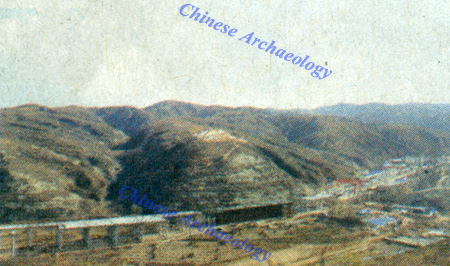
Distant view of Zhaimaoliang Site
There were much fewer ash pits. Most of the 14 pits were round tube-shaped or bag-shaped, all located within the house, which were supposed to be storage pits inside the house. Besides, there were 2 rectangular pits, all near the outfits of the house. Especially, rich quantities of pottery and broken bones were unearthed from pit K1 on the south of house F20 and F21. And several pottery shards from the pit can be refitted to those uncovered from house F20 and F21. Therefore, the pit could be outside storage pit with close relation to the building.
There are recovery pottery and more than 300 artifacts, including pottery, bones and stone artifacts and so on found in Zhaimaoliang Site.
Gray potteries are the mainstream of the pottery. Most of them are sand-tempered. The decorations are mainly basket-patterns and cord-patterns. The primary pottery shapes are li-vessels with two handles, li-vessels with single handle, urns with round base, urns with contracted mouth, dou-vessels with a skinny stand and so on.
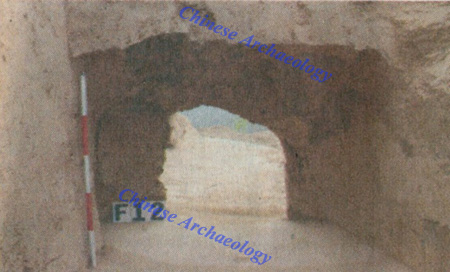
Gateway of F12 cave-dwelling
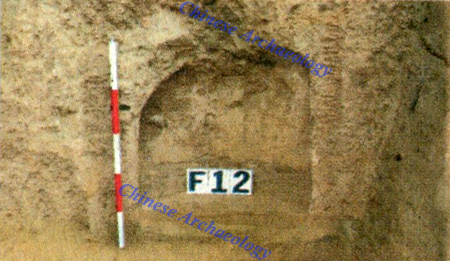
Gateway and threshold of F12 cave-dwelling
There are a relatively small amount of kinds of small pottery artifacts, including spindle wheels, flaking pottery knives and pottery rings. The bone artifacts mainly contain bone awls, needles, hairpins and so on. There are various kinds of stone artifacts ranging from stone rings, stone knives, stone axes, stone adzes, stone chisels, stone wedges, stone hammers, stone hoes, stone balls and etc. Besides, there are also some microlith, flakes and stone cores unearthed from the site.
Considering related research on similar remains found nearby, we believe that the main part of Zhaimaoliang Site should belong to Longshan Period from 4300BP to 4500 BP in Hetao Region.
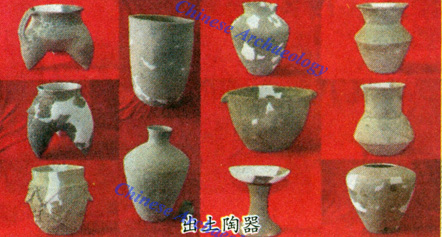
Pottery unearthed from the site
As the relatively well-preserved and most completely exposed prehistoric stone walled-ruin settlement from early period in Northern China so far, which has different kinds of features with clear stratigraphic relationship and close inner relationships, the excavation of Zhaimaoliang Site provides vital important materials for research on settlement pattern, household size and social structures and so on of the early phase of Longshan Period. This excavation was carried out within whole researching framework of Shimao Site. Thus, Zhaimaoliang Site should belong to ordinary or village level of shimao settlement. Therefore, if Shimao Site is regarded as the important symbol of the appearance of early state in northern part of Loess Plateau, comparison between Zhaimaoliang Site and Shimao Site will greatly enhance the understanding of evolution of social complex of this region. (Translator: Ma Huanhuan)

